"The Hypericum" - the storm "Tigers" and "Panther"
The SU-152 self-propelled gun, adopted by 14 in February of 1943, was in mass production before the start of the 1944. The appearance of these cars in the battle of Kursk was an unpleasant surprise for the Germans. A massive 152-mm armor-piercing projectile (48,8 kg), fired from a direct shot of 700 – 750 m, yanked off the tower from the Tiger. It was then that the heavy artillery firemen received the respectful nickname of “St. John's wort” from the soldiers.
It goes without saying that the military wanted to have a similar self-propelled gun on the basis of a new heavy tank, especially since the KV-1 was removed from production.
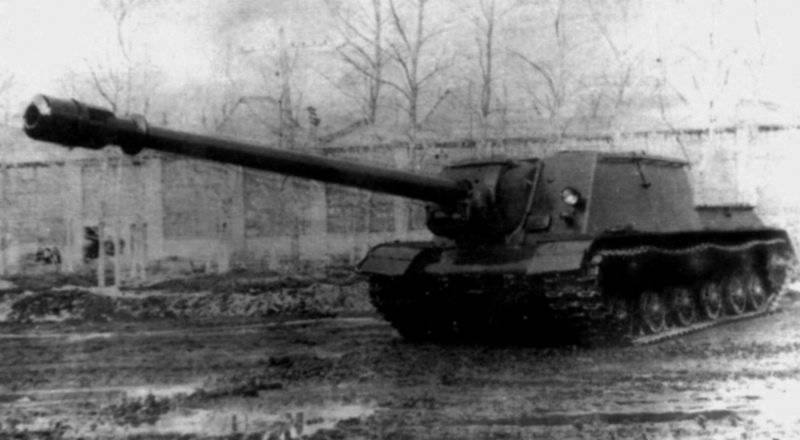
The layout of the ACS EC-152 (241 object), later called ICS-152, did not differ in fundamental innovations. Armored cabin, made of rolled sheets, was installed in the front of the hull, combining control and combat compartments into one volume. The thickness of its frontal armor was greater than that of SU-152: 60 – 90 mm against 60 – 75.
The ML-20 howitzer gun, caliber 152 mm, was mounted in a cast frame, which played the role of an upper machine tool, and was protected by the cast armor mask borrowed from the SU-152. The swinging part of the self-propelled howitzer-gun had minor differences compared to the field: a folding tray was installed to facilitate loading and a guard with a trigger, the handles of the flywheels of the lifting and turning mechanisms were at the gunner’s left along the car, the trunnions were moved forward for natural balancing.
The ammunition consisted of separate loading 20 shots, half of which were BR-545 armored-piercing shells weighing 48,78 kg, and half of high-explosive fragmentation cannon grenades OF-545 weighing 43,56 kg. For direct-fire shooting, a CT-10 telescopic sight served; for shooting from closed positions, a panoramic sight with an independent or semi-independent line of sight from a field howitzer ML-20. The maximum angle of elevation of the instrument was + 20 °, the declination is -3 °. At a distance of 1000 m armor-piercing projectile pierced 123-mm armor.
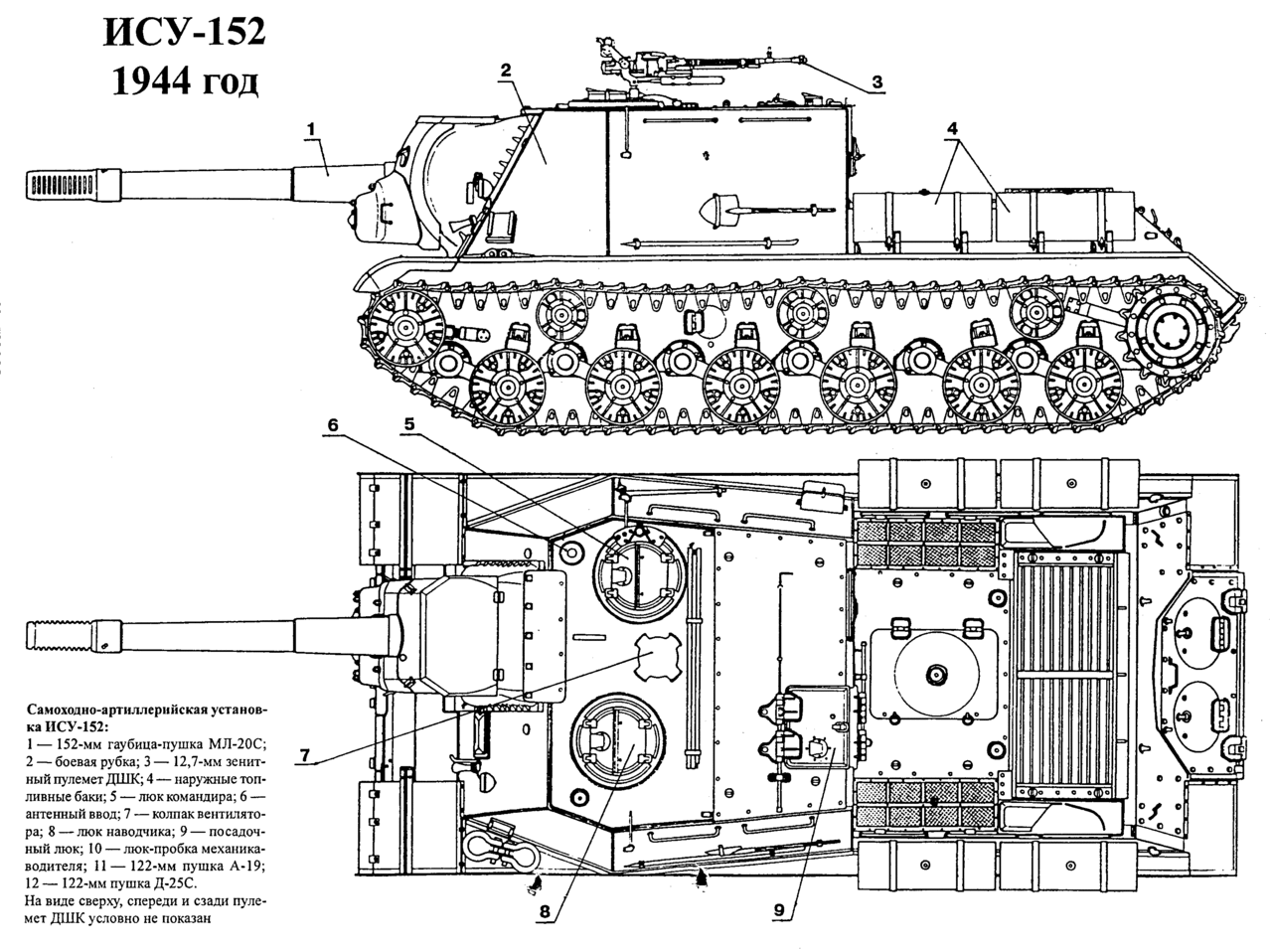
On the part of the machines on the antiaircraft turret of the commander's hatch was installed 12,7-mm machine gun DShK sample 1938 of the year.
The power plant and transmission were borrowed from the EC-2 tank and included an 12-cylinder four-stroke uncompressed liquid-cooled diesel engine B-2IS (B-2-10) hp 520. at 2000 rpm., multidisk main friction clutch for dry friction (steel on ferrodo), 4-chassis eight-speed gearbox with a multi-speed multiplexer, two-stage planetary rotation mechanisms with interlocking clutches and two-stage side gears with a planetary row.
The chassis of the ACS in relation to one side consisted of six twin cast support rollers with a diameter of 550 mm and three supporting rollers. The rear wheel drive wheels had two detachable gear rims with 14 teeth each. The directing wheels - cast, with the crank mechanism of a tension of caterpillars.
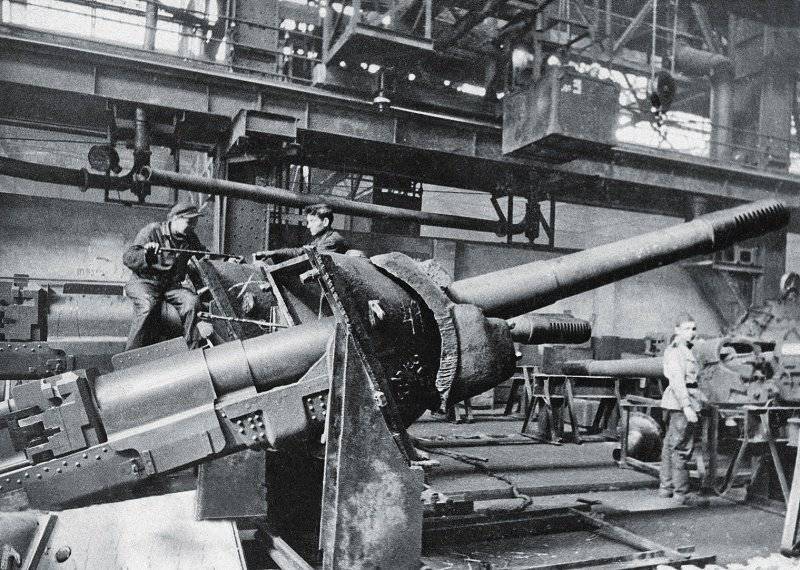
Suspension - individual torsion bar.
Caterpillars are steel, fine-molded, of single-ridge tracks from 86 each. Stamping tracks, 650 mm width and 162 mm pitch. Pinch gear.
The combat weight of ISU-152 was 46 t.
The maximum speed reached 35 km / h, power reserve - 220 km. The machines installed radio stations YUR or 10РК and intercom system TPU-4-bisF.
The crew included five people: the commander, gunner, loader, castle and driver-mechanic.
Already at the beginning of 1944, the release of ISU-152 began to be held back by the lack of ML-20 guns. To get out of this situation, at the artillery plant number 9 in Sverdlovsk, a barrel of 122-mm cannon A-19 was applied to the cradle of the ML-20С gun and as a result received a heavy artillery missile ICU-122 (242 object), due to the greater initial speed of the armor-piercing projectile - 781 m / s - was an even more effective anti-tank vehicle than MIS-152. Machine ammunition increased to 30 shots.
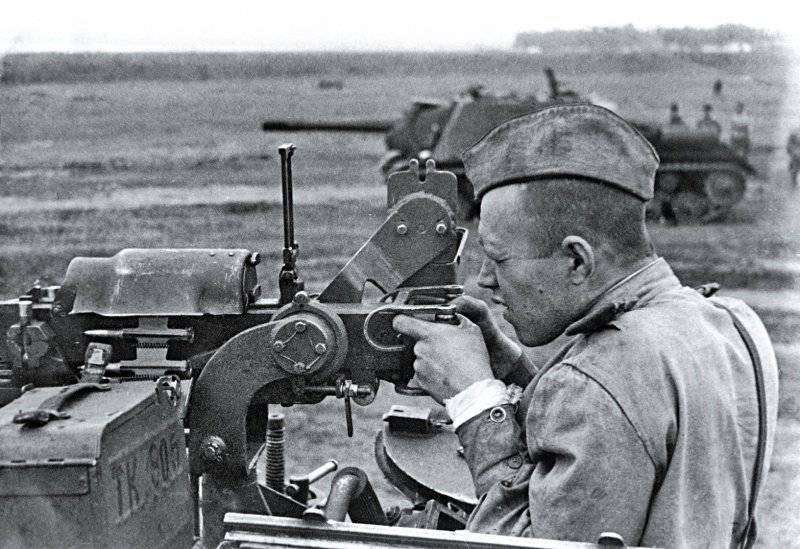
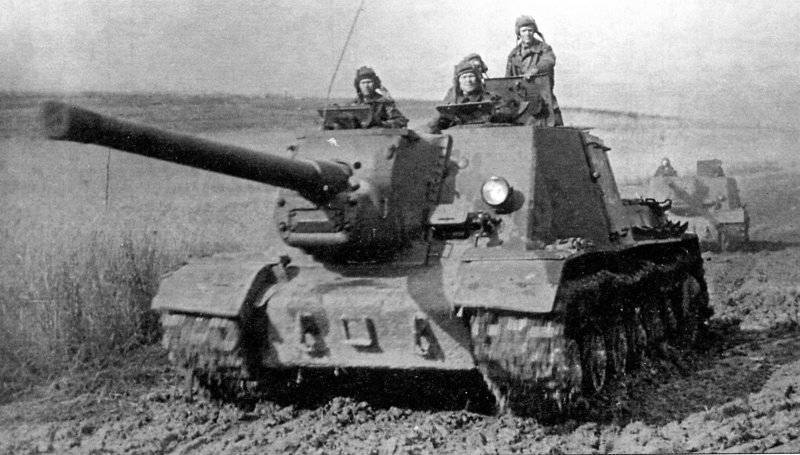
From the second half of 1944, on some ISU-122, they began to install the D-25С gun with a wedge semi-automatic shutter and a muzzle brake. These machines received the designation ISU-122-2 (249 object) or ISU-122C. They differed in the design of recoil devices, cradles and a number of other elements, in particular, the new cast mask 120 – 150 mm thick. Gun sights - telescopic TSH-17 and Hertz panorama. The convenient location of the crew in the combat compartment and the semi-automatic guns contributed to an increase in the rate of fire to 3 – 4 rds / min, compared to the 2 rds / min on the EC-2 and SAU IMS-122.
From 1944 to 1947, 2790 self-propelled units MIS-152, 1735 - MIS-122 and 675 - MIS-122C were manufactured. Thus, the total production of heavy artillery ships - 5200 units - exceeded the number of manufactured heavy tanks of the IC - 4499 units. It should be noted that, as in the case of the EC-2, the Leningrad Kirov Plant should be connected to the production of self-propelled guns at its base. Before 9 in May 1945, the first five ISU-152 were collected there, and by the end of the year - another hundred. In 1946 and 1947, production of MIS-152 was carried out only at LKZ.
Since the spring of 1944, the SU-152 heavy self-propelled artillery regiments were reequipped with the ISU-152 and ISU-122 installations. They were transferred to new states and were given the title of Guards to everyone. In total, until the end of the war, 56 of such regiments was formed, each had an 21 XIS-152 machine or an ISU-122 machine (some of these regiments had a mixed composition of machines). In March, the 1945 of the 66 th Guards Heavy Self-Propelled Artillery Brigade of the Three-Shelf Regiment (1804 Man, 65 ISU-122, ZSU-76) was formed.
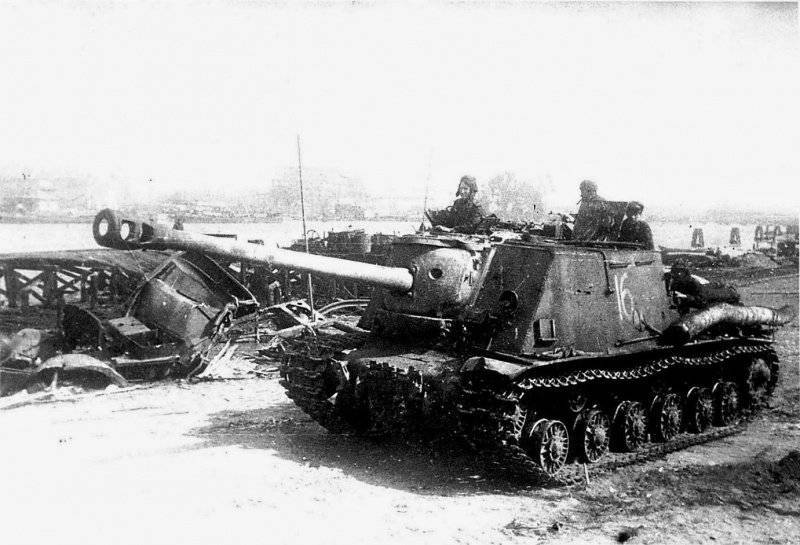
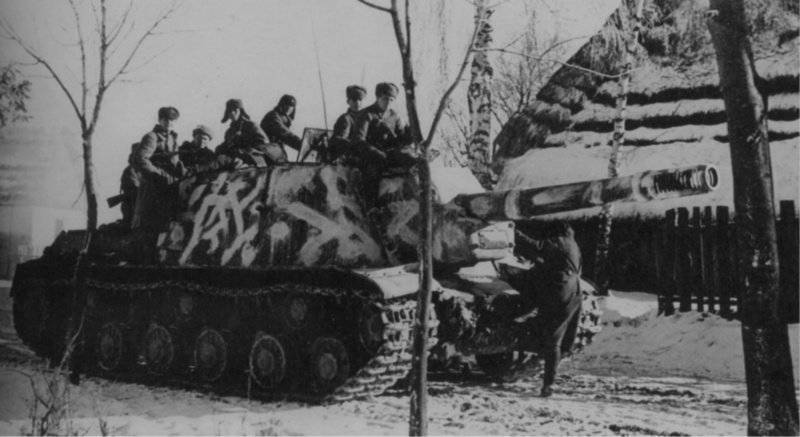
Heavy self-propelled artillery regiments attached to tank and rifle units and formations were primarily used to support infantry and tanks in the offensive. Following in their battle formations, the self-propelled guns destroyed the enemy firing points and ensured successful advance for the infantry and tanks. In this phase of the offensive ACS became one of the main means of repelling tank counterattacks. In a number of cases, they had to push forward the combat formations of their troops and take a hit, thereby ensuring the freedom of maneuver of supported tanks.
For example, 15 in January 1945 of the year in East Prussia, in the Borov area, the Germans used up to one motorized infantry regiment with the support of tanks and self-propelled guns to counterattack the battle formations of our advancing infantry, with which the 390 Guards heavy self-propelled artillery regiment operated. The infantry, under pressure from superior enemy forces, retreated to the battle formations of the self-propelled guns, who were hit by Germans with concentrated fire and covered the supported units. The counterattack was repulsed, and the infantry again had the opportunity to continue their offensive.
Heavy SPGs were sometimes involved in artillery preparation. At the same time, the fire was conducted both in direct fire and from closed positions. In particular, on January 12, 1945, during the Sandomierz-Silesian operation, the 368 Guards regiment of the ISU-152 1-th Ukrainian Front fired at the enemy’s 107 minutes for four minutes and four enemy artillery and mortar batteries. After releasing 980 shells, the regiment put down two mortar batteries, destroyed eight guns and up to one battalion of enemy soldiers and officers. It is interesting to note that the additional ammunition was laid out in advance at the firing positions, however, primarily the shells used in combat vehicles were spent, otherwise the rate of fire would be significantly reduced. For the subsequent replenishment of heavy self-propelled projectiles took up to 40 minutes, so they stopped firing in advance of the attack.
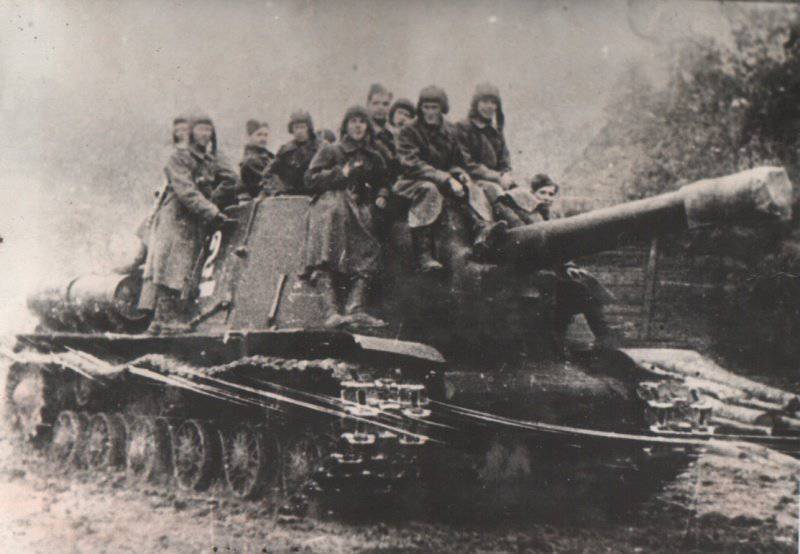
Very effectively heavy SPGs were used in the fight against enemy tanks. For example, in the Berlin operation 19 on April, the 360 th Guards Heavy Self-Propelled Artillery Regiment supported the offensive of the 388 Rifle Division. Part of the division captured one of the groves east of Lichtenberg, where they entrenched themselves. The next day, with the support of 15 tanks, the enemy began to counterattack with up to one infantry regiment. When repelling attacks during the day, 10 of German tanks and up to 300 soldiers and officers were destroyed by heavy SAU fire.
During the East Prussian operation, the 378 th guards heavy self-propelled artillery regiment successfully used the formation of the battle order of the regiment in the battles on the Zemland peninsula during the East Prussian operation. This provided the regiment with shelling in the 180 ° sector and more and made it easier to fight enemy tanks attacking from different directions.
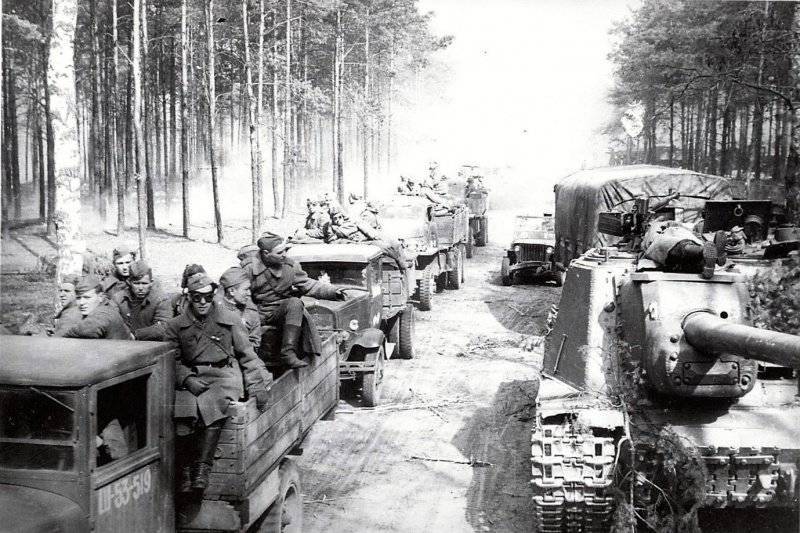
One of the ISU-152 batteries, having built its battle formation with a fan on the front with a length of 250 m, successfully repulsed 7 on April 1945, a counter attack of 30 enemy tanks, knocking out six of them. Battery loss is not suffered. Only two cars received minor damage to the chassis.
Back in December, 1943 of the year, given that in the future the enemy could have new tanks with more powerful armor, the State Special Forces ordered to design and manufacture self-propelled artillery units with increased power by April 1944:
• with an 122-mm gun, which has an initial speed of 1000 m / s with a projectile mass in 25 kg;
• with an 130-mm gun, which has an initial speed of 900 m / s with a projectile mass in 33.4 kg;
• with an 152-mm gun, which has an initial speed of 880 m / s with a projectile mass in 43.5 kg.
All these guns pierced armor 200 mm thick at a distance of 1500 – 2000 m.
During the execution of this decree, the artillery strips were developed and tested in 1944 – 1945: MIS-122-1 (243 object) with a 122-mm gun BL-9, MIS-122-3 (251 object) with an 122-mm gun 26-1, ISU-130 (250 object) with 130-mm C-26 gun; MIS-152-1 (246 object) with 152-mm gun BL-8 and MIS-152-2 (247 object) with 152-mm gun BL-10.
The C-26 and C-26-1 guns were designed at TsACB under the direction of V.Grabin, while the C-26-1 differed from the C-26 only in the caliber of the pipe. The 26 mm C-130 cannon had ballistics and ammunition from the B-13 naval cannon, but it had a number of fundamental design differences, as it was equipped with a muzzle brake, a horizontal wedge, etc. The IMS-130 and IMS-122-1 movers were manufactured at the factory No. 100, and they passed the tests from 30 June to 4 August 1945. Later, the tests continued, but both SAUs were not put into service and were not launched into the series.
The guns BL-8, BL-9 and BL-10 developed OKB-172 (not to be confused with the plant number 172), all the designers of which were prisoners. The first prototype BL-9 was manufactured in May at 1944 of the year at plant No. 172, and in June it was installed on ISU-122-1. Its field tests were carried out in September 1944, and the state tests in May 1945. At the last when shooting there was a rupture of the trunk due to metal defects. The BL-8 and BL-10 X-guns of the 15 mm caliber had ballistics substantially exceeding those of the ML-20, and were tested in the 1944 year.
Self-propelled guns with prototypes of guns were characterized by the same drawbacks as the rest of the ACS on the IC chassis: a large forward flight of the barrel, which reduced maneuverability in narrow aisles; small angles of horizontal guidance of the gun and the complexity of its guidance, which made it difficult to shoot at mobile targets; low combat rate of fire due to the relatively small size of the fighting compartment, a large mass of shots, separate-cartridge loading and the presence of a number of guns piston bolt; poor visibility of the cars; small ammunition and the complexity of its replenishment during the battle.
At the same time, a good counter-shear resistance of the hull and cabin of these self-propelled guns, achieved by installing powerful armor plates at rational tilt angles, made it possible to use them at a distance of a direct shot and quite effectively hit any targets.
The ISU-152 self-propelled artillery mounts were in service with the Soviet Army until the end of the 70-s, up to the beginning of the arrival of the new-generation ACS. At the same time, ISU-152 was upgraded twice. The first time in 1956 was when SAU received the designation IMS-152K. On the roof of the cabin, a commander's tower was installed with a TPKU device and seven viewing blocks of TYPE; the ammunition of the ML-20 howitzer gun was increased to 30 shots, which required a change in the location of the internal equipment of the combat compartment and additional ammunition packs; instead of the ST-10 sight, the PS-10 advanced telescopic sight was installed. All machines mounted anti-aircraft machine gun DShKM with 300 ammunition ammunition.
On the ACS, the B-54K engine was installed with the HP 520 power. with ejection cooling system. The capacity of the fuel tanks increased to 1280l. The lubrication system was improved, the design of radiators became different. In connection with the ejection cooling system of the engine, the mounting of the external fuel tanks was also changed.
Machines equipped with radio stations 10-RTiTPU-47.
The mass of self-propelled guns increased to 47,2 t, but the dynamic characteristics remained the same. Power reserve increased 360 km.
The second version of the modernization had the designation ISU-152M. The machine was equipped with modified units of the IS-2М tank, a DShKM anti-aircraft machine gun with 250 ammunition ammunition and night vision devices.
During the overhaul, self-propelled guns ISU-122 were subjected to some alterations. So, since 1958, full-time radio stations and TPUs have been replaced with Granat radio stations and P-120 TPU.
In addition to the Soviet Army, ISU-152 and ISU-122 were in service with the Polish Army. As part of the 13 and 25 regiments of self-propelled artillery, they took part in the final battles of 1945. Soon after the war, the Czechoslovak People's Army received ISU-152. At the beginning of the 60, one regiment of the Egyptian army also had ISU-152 in service.

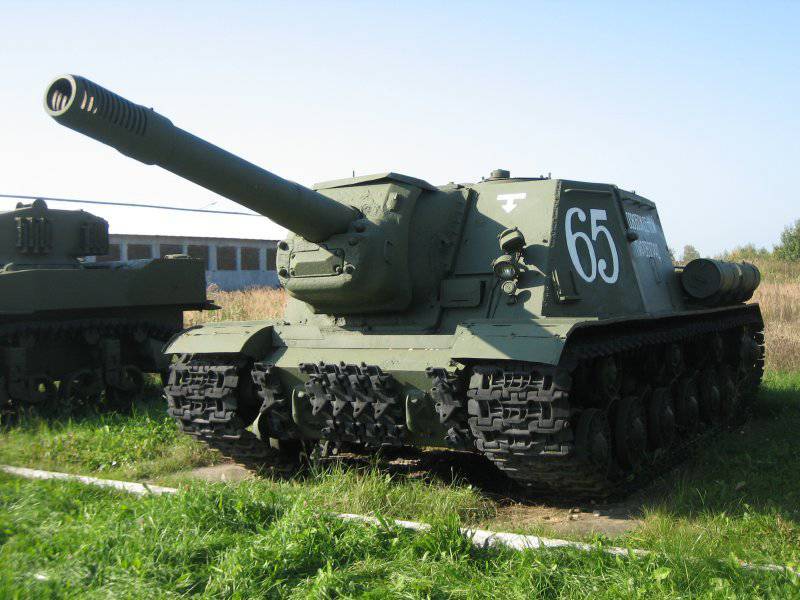
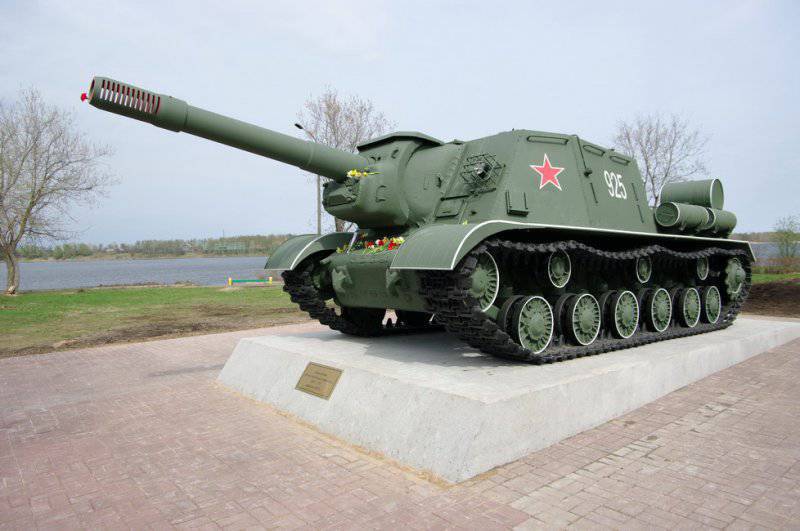
Information